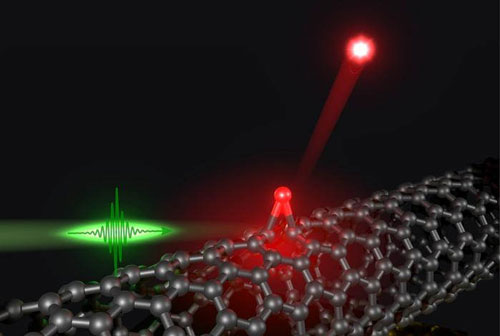| Posted: Sep 07, 2015 |
Carbon nanotubes open new path toward quantum information technologies
(Nanowerk News) In optical communication, critical information ranging from a credit card number to national security data is transmitted in streams of laser pulses. However, the information transmitted in this manner can be stolen by splitting out a few photons (the quantum of light) of the laser pulse. This type of eavesdropping could be prevented by encoding bits of information on quantum mechanical states (e.g. polarization state) of single photons. The ability to generate single photons on demand holds the key to realization of such a communication scheme.
|
|
By demonstrating that incorporation of pristine single-walled carbon nanotubes into a silicon dioxide (SiO2) matrix could lead to creation of solitary oxygen dopant state capable of fluctuation-free, room-temperature single photon emission, Los Alamos researchers revealed a new path toward on-demand single photon generation. Nature Nanotechnology published their findings ("Room-temperature single-photon generation from solitary dopants of carbon nanotubes").
|
 |
| A solitary oxygen dopant (red sphere) covalently attached to the sidewall of the carbon nanotube (gray) can generate single photons (red) at room temperature when excited by laser pulses (green).
|
|
Significance of the research
|
|
Photons emitted from lasers are distributed randomly in time. Therefore, “simultaneous” emission of two or more photons is possible. True single photon generation requires an isolated quantum mechanical two-level system that can emit only one photon in one excitation-emission cycle. Technological requirements of materials for quantum communication include the ability to generate single photons in the 1,300 – 1,500 nanometer (nm) telecommunication wavelength range at room temperature and compatibility with silicon microfabrication technology to enable electrical stimulation and integration of other electronic and photonic network components. Earlier studies revealed that carbon nanotubes present technical challenges for use in quantum communications: 1) the materials were capable of single photon emission only at cryogenic temperature, and 2) their inefficient emission had strong fluctuations and degradation.
|
|
The Laboratory’s new research has demonstrated that incorporation of pristine carbon nanotubes into a silicon dioxide (SiO2) matrix could lead to incorporation of solitary oxygen dopant states capable of fluctuation-free, room-temperature single photon emission in the 1100 - 1300 nm wavelength range.
|
|
The oxygen-doped nanotubes can be encapsulated in a SiO2 layer deposited on a silicon wafer. This presents an opportunity to apply well-established micro-electronic fabrication technologies for the development of electrically driven single photon sources and integration of these sources into quantum photonic devices and networks. Beyond implementation of quantum communication technologies, nanotube-based single photon sources could enable transformative quantum technologies including ultra-sensitive absorption measurements, sub-diffraction imaging, and linear quantum computing. The material has potential for photonic, plasmonic, optoelectronic, and quantum information science applications.
|
|
Research achievements
|
|
By using a state-of-the-art photon detector, the team measured the temporal distribution of two successive photon emission events and demonstrated single photon emission. In addition, the team investigated the effects of temperature on photoluminescence emission efficiencies, fluctuations, and decay dynamics of the dopant states in the single-walled carbon nanotube. The researchers determined the conditions most suitable for the observation of single-photon emission. In principle, the emission could be tuned to 1500 nm via doping of smaller band-gap single-walled carbon nanotubes. This is a distinct advantage compared with some other materials, in which single photon emission is possible for only a few discrete wavelengths shorter than 1 µm.
|

